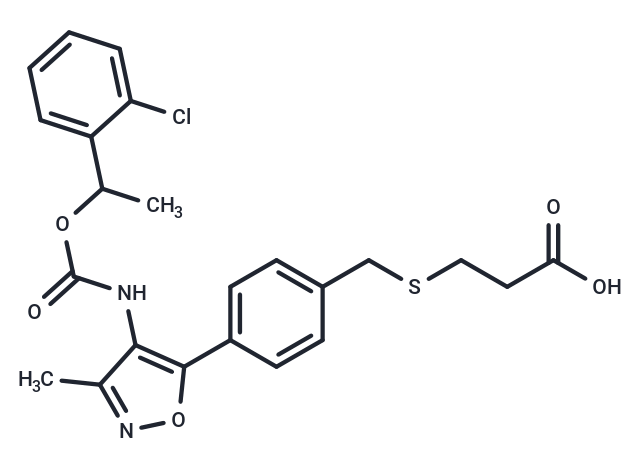Shopping Cart
- Remove All
 Your shopping cart is currently empty
Your shopping cart is currently empty

Ki16425 (Debio 0719) is a competitive, potent, and reversible antagonist to LPA1, LPA2, and LPA3, with Ki values of 0.34 μM, 6.5 μM, and 0.93 μM, respectively.

| Pack Size | Price | Availability | Quantity |
|---|---|---|---|
| 2 mg | $35 | In Stock | |
| 5 mg | $52 | In Stock | |
| 10 mg | $90 | In Stock | |
| 25 mg | $198 | In Stock | |
| 50 mg | $387 | In Stock | |
| 100 mg | $541 | In Stock | |
| 1 mL x 10 mM (in DMSO) | $54 | In Stock |
| Description | Ki16425 (Debio 0719) is a competitive, potent, and reversible antagonist to LPA1, LPA2, and LPA3, with Ki values of 0.34 μM, 6.5 μM, and 0.93 μM, respectively. |
| Targets&IC50 | LPA2:6.5 μM(Ki), LPA1:0.34 μM(Ki), LPA3:0.93 μM(Ki) |
| In vitro | Kil6425 preferentially inhibits LPA1- and LPA3-mediated responses but has only a moderate effect on LPA2. Ki16425 inhibits the LPA-induced Ca(2+) response in THP-1 cells, 3T3 fibroblasts, and A431 cells, but had only a marginal effect in PC-12 cells and HL-60 cells, which means that Ki16425 seems to be a useful tool for evaluating the involvement of specific LPA receptors in the short-term response to LPA. Ki16425 inhibits long-term DNA synthesis and cell migration as induced by LPA in Swiss 3T3 fibroblasts. [1] Ki16425 reduces the LPA-induced activation of p42/p44 mitogen activated protein kinase (MAPK), while acting as a weak stimulator of p42/p44 MAPK on its own, properties typical of a protean agonist. Ki16425 also significantly reduces the NGF-induced stimulation of p42/p44 MAPK and inhibited NGF-stimulated neurite outgrowth in PC-12 cells. [2] Ki16425 markedly inhibits the expressions of COX-2 protein induced by synovial fluids. The enhancement of the IL-1 action by LPA on COX-2 expression is also inhibited by Ki16425. [3] |
| In vivo | Ki-16425 (30 mg/kg, i.p.) completely blocks LPA-induced neuropathic pain-like behaviors, when administered 30 min but not 90 min before lysophosphatidic acid injection, suggesting that Ki-16425 is a short-lived inhibitor. Ki-16425 also inhibits nerve injury-induced up-regulation of Caα2δ-1 in the dorsal root ganglion and reduction of SP immunoreactivity in the spinal dorsal horn. [4] |
| Kinase Assay | High-throughput screening: Screening is conducted at the ICCB-Longwood screening facility. 10 μL of recombinant USP14 protein are dispensed into each well of a 384-well low volume plate in duplicate, using a Wellmate plate dispenser. 33.3?nL of compound from the library are pin-transferred into the wells using a Seiko pin transfer robotic system, followed by pre-incubation for about 30?min. The last two columns of each plate are used for positive and negative controls for the assay. To initiate the enzyme reaction, 10?μL of VS-proteasome plus Ub-AMC mixture are added to each well, using a Wellmate dispenser. Samples are then incubated for another 45?min. Ub-AMC hydrolysis is measured at Ex355/Em460 using an Envision plate reader. The final concentrations of USP14, VS-proteasome and Ub-AMC are 15?nM, 1?nM and 0.8 μM, respectively. The final concentration of test compound is approximately 17?μM. Enzymes and substrates are prepared in Ub-AMC assay buffer (50?mM Tris-HCl (pH?7.5), 1?mM EDTA, 1?mM ATP, 5 mM MgCl2, 1?mM DTT, and 1 mg/Ml ovalbumin). |
| Alias | Debio 0719 |
| Molecular Weight | 474.96 |
| Formula | C23H23ClN2O5S |
| Cas No. | 355025-24-0 |
| Smiles | CC(OC(=O)Nc1c(C)noc1-c1ccc(CSCCC(O)=O)cc1)c1ccccc1Cl |
| Relative Density. | 1.353 g/cm3 |
| Storage | Powder: -20°C for 3 years | In solvent: -80°C for 1 year | Shipping with blue ice. | |||||||||||||||||||||||||||||||||||
| Solubility Information | DMSO: 94 mg/mL (197.91 mM), Sonication is recommended. H2O: < 1 mg/mL (insoluble or slightly soluble) Ethanol: 84 mg/mL (176.86 mM), Sonication is recommended. | |||||||||||||||||||||||||||||||||||
Solution Preparation Table | ||||||||||||||||||||||||||||||||||||
Ethanol/DMSO
| ||||||||||||||||||||||||||||||||||||

Copyright © 2015-2025 TargetMol Chemicals Inc. All Rights Reserved.